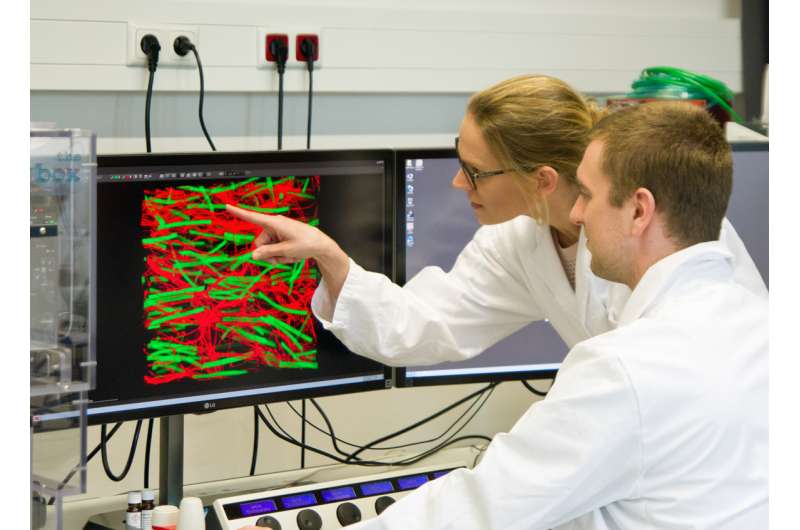An injectable guidance system for nerve cells

In many tissues of the human body, including nerve tissue, the spatial organization of cells plays an important role. Nerve cells and their long protrusions assemble into nerve tracts and transport information throughout the body. When nerve tissue is injured, an accurate spatial orientation of the cells facilitates the healing process. Scientists from the DWI – Leibniz Institute for Interactive Materials in Aachen developed an injectable gel that can act as a guidance system for nerve cells. They recently published their results, obtained from cell culture experiments, in the journal Nano Letters.
Inside the body, an extracellular matrix surrounds the cells. It provides mechanical support and promotes spatial tissue organization. In order to regenerate damaged tissue, an artificial matrix can temporally replace the natural extracellular matrix. This matrix needs to mimic the natural cell environment in order to efficiently stimulate the regenerative potential of the surrounding tissue. Solid implants, however, may impair remaining healthy tissue, whereas soft, injectable materials allow for minimally invasive therapy, which is particularly beneficial for sensitive tissues, such as the spinal cord. Unfortunately, until now, artificial soft materials cannot reproduce the complex structures and spatial properties of natural tissues.
A team of scientists, headed by Dr. Laura De Laporte from the DWI – Leibniz Institute for Interactive Materials developed a new, minimally invasive material called Anisogel. "If you aim to enhance the regeneration of damaged spinal cord tissue, you need to come up with a new material concept," says Jonas Rose, a Ph.D. student working on the Anisogel project.
"We use micrometer-sized building blocks and assemble them into 3-D hierarchically organized structures." Anisogel consists of two gel components. Microscopic, soft, rod-shaped gels incorporated with magnetic nanoparticles are the first component. Using a weak magnetic field, scientists can orient the gel rods, after which a very soft surrounding gel matrix is cross-linked, forming the structural guidance system. The gel rods, being stabilized by the gel matrix, maintain their orientation, even after removal of the magnetic field.
Using cell culture experiments, the researchers demonstrated that cells can easily migrate through this gel matrix, and that nerve cells and fibroblasts orient along the paths provided by this guidance system. A low number of gel rods within the entire Anisogel volume is proven to be sufficient to induce linear nerve growth. The material, developed by the Aachen-based scientists, is the first injectable biomaterial that assembles into a controlled oriented structure after injection and provides a functional guidance system for cells. "To meet the complex requirements of this approach, the project team includes researchers with very different areas of expertise," says Laura De Laporte. "This interdisciplinary work is what makes this project so fascinating."
"Although our cell culture experiments were successful, we are prepared to go a long way to translate our Anisogel into a medical therapy. In collaboration with the Uniklinik RWTH Aachen, we currently plan pre-clinical studies to further test and optimize this material," Laura De Laporte explains.
More information: Rose, J. C., Cámara-Torres, M., Rahimi, K., Köhler, J., Möller, M., & De Laporte, L. (2017). Nerve Cells Decide to Orient inside an Injectable Hydrogel with Minimal Structural Guidance. Nano Letters. DOI: 10.1021/acs.nanolett.7b01123
Journal information: Nano Letters
Provided by Leibniz Institute for Interactive Materials



















